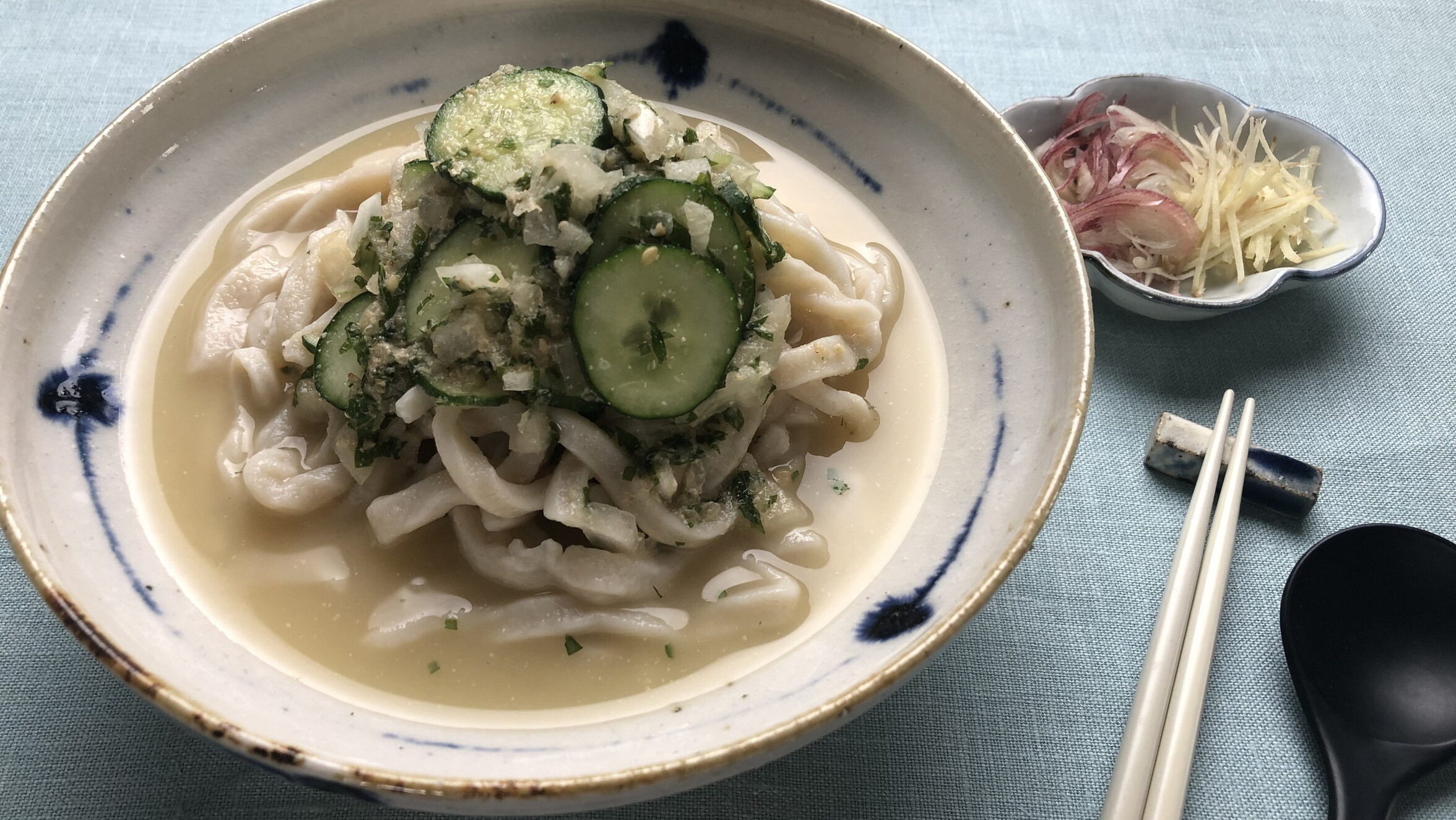
Alright, gather ’round folks, let me tell you about a real classic – Hiyajiru, or as they call it in Kawashima Town, Suttate! [cite: 1, 2, 3, 4] It’s a chilled soup that’s like a big ol’ hug on a hot summer day, and it’s got deep roots here in Saitama. [cite: 1, 2, 3, 4] This dish is all about using what’s good and local, and it’s a testament to the ingenuity of the farmers who came before us.
Dish Name: Hiyajiru / Suttate (冷や汁/すったて)
- Region / Location: Kawashima Town, Iruma area, Northern Saitama Prefecture
- Primary Area of Tradition: Kawashima Town, Iruma area, Northern Saitama Prefecture
- Main Ingredients: Vegetables
How It’s Eaten / Served
Hiyajiru is a chilled soup that has evolved uniquely in various regions across Japan, using locally available vegetables and fish. [cite: 5, 6, 7] Saitama’s version is closely tied to the area’s “udon culture,” where wheat cultivation was common as a secondary crop to rice. [cite: 5, 6, 7] So, Hiyajiru became a popular dipping sauce for udon noodles. [cite: 8, 9, 10] Back in the day, farming was mostly manual labor, and rice farmers were super busy from planting to harvest, working from dawn till dusk. [cite: 8, 9, 10] Hiyajiru was a lifesaver because it was easy to make and packed with nutrients, perfect for those hectic farming periods. [cite: 11, 12, 13] Kawashima Town, surrounded by rivers and blessed with fertile land, has a long history of rice cultivation, and Hiyajiru, or “Suttate” as they call it there, was a staple food for farm families. [cite: 11, 12, 13] The name “Suttate” comes from the fact that the ingredients, like vegetables, were ground up in a “suribachi” (mortar), and they ate it “suri-tate” (freshly ground). [cite: 14] It’s also known as “Hiyashi-jiru” (冷やし汁) or “Tsuttate” (つったて). [cite: 15, 16] To make it, you grind sesame seeds and miso in a suribachi, then add a bunch of refreshing veggies like cucumber, perilla leaves (shiso), and Japanese ginger (myoga). [cite: 15, 16] Finally, you pour in cold water and mix it all up. [cite: 17] In Kawashima’s Suttate, they grind the vegetables in the suribachi too, which is a key characteristic. [cite: 17] And it’s not just for udon; some folks like to generously ladle it over rice!
Cultural Background and Preservation
Hiyajiru, made with freshly harvested vegetables and cold water, was a beloved dish for farmers working under the hot summer sun. [cite: 18, 19] It’s seasoned with miso, which is rich in protein and helps replenish salt, and the addition of summer vegetables like cucumber, shiso, and myoga makes it a refreshing and appetizing meal, even on those days when you don’t have much of an appetite because of the heat. [cite: 20] Today, Hiyajiru isn’t just a farmhouse dish; it’s a regular summer item in households. [cite: 20] Restaurants in the prefecture are also serving it up, using local ingredients and adding their own twists to the noodles and broth. [cite: 21] Kawashima Town’s mascot, “Kawabee,” even carries a surikogi (pestle) for making Suttate and wears an outfit that looks like a bowl!
Additional information:
- Suribachi (すり鉢): A Japanese mortar, typically made of earthenware with a rough interior, used for grinding ingredients.
- Surikogi (擂粉木): A wooden pestle used with a suribachi.
- Shiso (紫蘇): Also known as perilla, an aromatic herb often used in Japanese cooking.
- Myoga (茗荷): Japanese ginger, a type of ginger with a distinctive flavor and aroma.
The information about regional cuisine featured on this website (Piggy's Grandma of Japan) is summarized and adapted from the Ministry of Agriculture, Forestry and Fisheries of Japan (MAFF) website, "Our Regional Cuisines"Additional commentary is provided based on the unique experiences and perspectives of the site's editors.
The copyright for the original content regarding regional cuisine belongs to the Ministry of Agriculture, Forestry and Fisheries of Japan.
The summaries and adaptations published on this site are intended for informational purposes only. Piggy's Grandma of Japan does not guarantee the accuracy or completeness of this information. For the most accurate and complete details, please refer to the original pages on the MAFF website.

